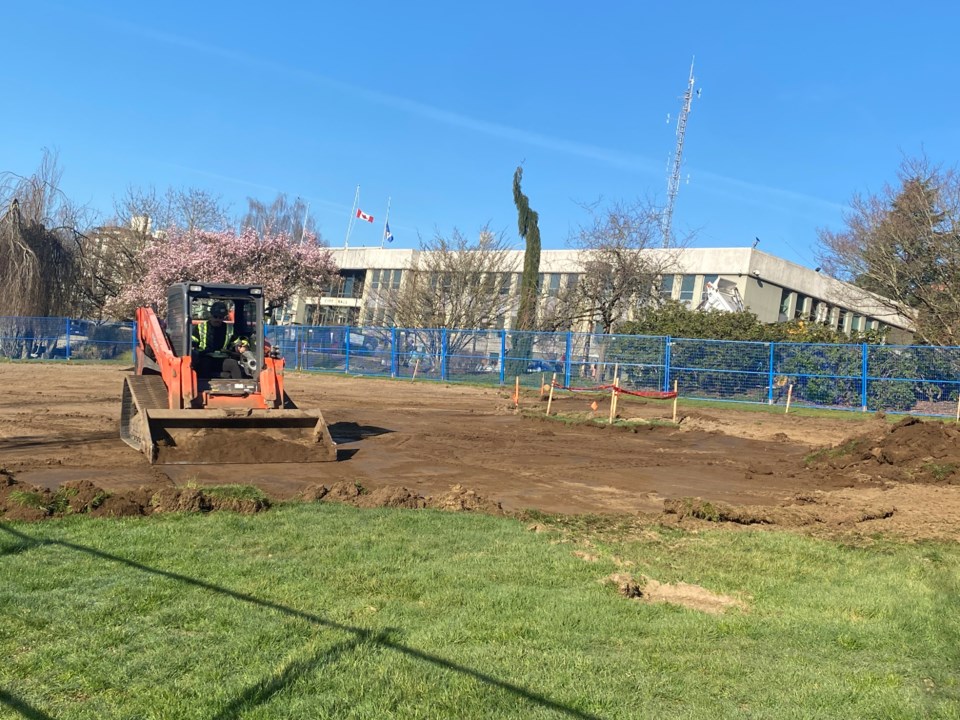New Westminster is in the midst of transforming the space in front of city hall to include a grove of trees.
In March 2023, city council approved a plan that would see a full grove of up to 60 deciduous trees planted on a grid. The concept includes a tall grass and wildflower mix below the tree canopy and mowed pathways to accommodate pedestrians.
That work is now underway.
Erika Mashig, the city’s manager of parks and open space planning, design and construction, said the city now anticipates about 40 trees will be planted in a formal grid pattern in an area of front lawn of city hall. She said the area will feature a mix of deciduous tree species that have seasonal interest.
“The grove of trees will grow and help increase the city’s overall tree canopy coverage, improve air quality, sequester carbon, infiltrate storm water, buffer vehicular traffic from Royal Avenue and, over time, increase wildlife habitat,” she said.
According to a notice from the city, work on the project began on March 18 and is expected to take about two weeks to complete.
Mashig said the species that are being planted at city hall were selected as they’re expected to adapt to climate change – longer periods of heat and drought.
In response to the weather conditions in recent years, the city is taking some steps to ensure the trees survive and thrive.
Mashig said this includes: planting trees species that are expected to thrive in our changing climate; providing adequate and high quality soil to hold water; and irrigating newly planted trees on a regular schedule for three years from May to October to promote root establishment.
Mayor Patrick Johnstone took to social media last week to let community members know that “big changes” are coming to New Westminster City Hall.
“The city is committed to bringing back a healthy urban forest. Trees provide numerous benefits to a dense urban community, from cleaning the air to lowering the temperature to providing pollinator habitat and storm water entrainment,” he wrote on Facebook. “Part of this is finding opportunities to shift from grass field to healthy forest in ways that won’t take away critical recreation space in the city.”
Johnstone said the space in front of city hall “might be a bit messy” in the short term while work is underway to prepare the space and to plant the trees. He assured community members that the area in front of city hall would still be able to accommodate gatherings – including Remembrance Day ceremonies at the Cenotaph and picnics during the New West Farmers Market.
“We don’t plant trees for today, we do it for the decades ahead,” he wrote. “They are a gift to the next generations.”
Mashig said the City of New Westminster received $1.7 million in provincial and federal funding for its Urban Reforestation and Biodiversity Enhancement Initiative. The funding was part of the Investing in Canada Infrastructure Program – COVID-19 Resilience Infrastructure Stream.
According to Mashig, this funding, which covers the cost of planting 2,200 new trees across New West, including city hall’s front lawn, will help the city achieve its goals of expanding the tree canopy.
“The URBEI funding is helping to achieve New Westminster’s urban forest canopy cover target of 27 per cent by 2030 to support the removal of 4,050 tonnes of carbon pollution every year and increase our forest’s carbon storage capacity by 50 per cent,” she said. “As part of this initiative, there is an opportunity transform city hall's front lawn into a sustainable civic landscape that better reflects city’s commitment to climate action and increasing biodiversity.”




